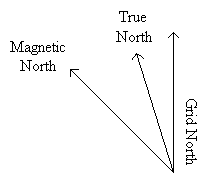When working with a map and compass there are usually three different norths to be considered: True North, Grid North and Magnetic North. There is now a fourth: Google Maps North.
True North

Each day the Earth rotates about its axis once. The ends of the axes are the True North and South poles. True North on a map is the direction of a line of longitude which converges on the North Pole.
Grid North
The grid lines on Ordnance Survey maps divide the UK into one kilometre squares, east of an imaginary zero point in the Atlantic Ocean, west of Cornwall. The grid lines point to a Grid North, varying slightly from True North. This variation is smallest along the central meridian (vertical line) of the map, and greatest at the map edges. The difference between grid north and true north is very small and for most navigation purposes can almost always be ignored.
Magnetic North
A compass needle points to the magnetic north pole. The magnetic north pole is currently located in the Baffin Island region of Canada, and from the UK, is west of true north. The horizontal angular difference between True North and Magnetic North is called MAGNETIC VARIATION or DECLINATION.
Google Maps North
Google Maps use a variant of the Mercator projection for its map images. The Mercator map was designed as an aid to navigators since straight lines on the Mercator projection are loxodromes or rhumb lines – representing lines of constant compass bearing – perfect for ‘true’ direction.
True North on Google Maps is not shown, but for a normal Mercator projection, grid north and true north will coincide and it will follow any vertical line (or meridian) to the top of the map.
Source: http://googlecompass.com/TypesofNorth.htm






























